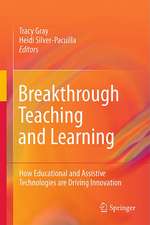Designing for Change in Networked Learning Environments: Computer-Supported Collaborative Learning Series, cartea 2
Editat de B. Wasson, Sten Ludvigsen, Ulrich Hoppeen Limba Engleză Hardback – 30 iun 2003
Computer Support for Collaborative Learning (CSCL) is a genuinely interdisciplinary field that strives to create a better understanding of collaborative learning that is mediated by a diverse set of computational technologies. The theme of CSCL 2003 "Designing for Change in Networked Learning Environments" reflects a commitment to influence educational practice in times of the Internet. The contributions in this volume include discussions on knowledge building, designing and analysing group interaction, design of collaborative multimedia and 3D environments, computational modelling and analysis, software agents, and much more.
| Toate formatele și edițiile | Preț | Express |
|---|---|---|
| Paperback (1) | 1229.10 lei 6-8 săpt. | |
| SPRINGER NETHERLANDS – 29 ian 2011 | 1229.10 lei 6-8 săpt. | |
| Hardback (1) | 1241.25 lei 6-8 săpt. | |
| SPRINGER NETHERLANDS – 30 iun 2003 | 1241.25 lei 6-8 săpt. |
Din seria Computer-Supported Collaborative Learning Series
- 15%
 Preț: 659.53 lei
Preț: 659.53 lei - 15%
 Preț: 648.42 lei
Preț: 648.42 lei -
 Preț: 387.38 lei
Preț: 387.38 lei - 18%
 Preț: 1832.53 lei
Preț: 1832.53 lei - 18%
 Preț: 951.29 lei
Preț: 951.29 lei - 15%
 Preț: 642.83 lei
Preț: 642.83 lei - 18%
 Preț: 1135.35 lei
Preț: 1135.35 lei - 18%
 Preț: 949.55 lei
Preț: 949.55 lei - 18%
 Preț: 1021.68 lei
Preț: 1021.68 lei - 18%
 Preț: 1398.94 lei
Preț: 1398.94 lei - 15%
 Preț: 639.73 lei
Preț: 639.73 lei - 15%
 Preț: 645.28 lei
Preț: 645.28 lei - 18%
 Preț: 953.20 lei
Preț: 953.20 lei - 18%
 Preț: 955.25 lei
Preț: 955.25 lei - 18%
 Preț: 1116.09 lei
Preț: 1116.09 lei - 15%
 Preț: 646.11 lei
Preț: 646.11 lei - 15%
 Preț: 641.03 lei
Preț: 641.03 lei
Preț: 1241.25 lei
Preț vechi: 1513.71 lei
-18% Nou
Puncte Express: 1862
Preț estimativ în valută:
237.51€ • 248.65$ • 196.53£
237.51€ • 248.65$ • 196.53£
Carte tipărită la comandă
Livrare economică 05-19 aprilie
Preluare comenzi: 021 569.72.76
Specificații
ISBN-13: 9781402013836
ISBN-10: 1402013833
Pagini: 560
Ilustrații: XX, 536 p.
Dimensiuni: 156 x 234 x 35 mm
Greutate: 1.12 kg
Ediția:2003
Editura: SPRINGER NETHERLANDS
Colecția Springer
Seria Computer-Supported Collaborative Learning Series
Locul publicării:Dordrecht, Netherlands
ISBN-10: 1402013833
Pagini: 560
Ilustrații: XX, 536 p.
Dimensiuni: 156 x 234 x 35 mm
Greutate: 1.12 kg
Ediția:2003
Editura: SPRINGER NETHERLANDS
Colecția Springer
Seria Computer-Supported Collaborative Learning Series
Locul publicării:Dordrecht, Netherlands
Public țintă
ResearchCuprins
1.1 Representational tools and the transformation of learning.- 1.2 How sensing and mobile technologies can enhance collaborative learning in classrooms and museums.- 2.1 Comparing graphical and textual preparation tools for collaborative argumentation-based learning.- 2.2 Computer-supported collaborative learning in the space of debate.- 2.3 Assessing and scaffolding knowledge building: Pedagogical knowledge building principles and electronic portfolios.- 2.4 Primeclimb: Designing to facilitate mediated collaborative inquiry.- 2.5 Problematizing the problem: A single case analysis in a dPBL meeting.- 2.6 A quartet in E: Investigating collaborative learning and tutoring as knowledge creation processes.- 2.7 Developmental trajectory in knowledge building: An investigation.- 2.8 Categorisation in knowledge building: Task specific argumentation in a co-located CSCL environment.- 2.9 Grounding in electronic discussion: Standard (threaded) versus anchored discussion.- 2.10 Supporting emergence of threaded learning conversations through augmenting interactional and sequential coherence.- 3.1 Supporting historical reasoning in CSCL.- 3.2 Collaborative modelling of rational numbers.- 3.3 Students’ collaborative use of computer-based programming tools in science: A descriptive study.- 4.1 Promoting interaction in large classes with computer-mediated feedback.- 4.2 Some experiences with collaborative exercises.- 4.3 New breed of computer supported student contests: Learning by and for tele-collaboration.- 5.1 Towards lifelong learning environments: Agents supporting the collaborative construction of knowledge in virtual communities.- 5.2 Designing pedagogical agents for Cscl.- 5.3 Integrating software agents with.- 6.1 Validating a representational notation for collaborativeproblem solving.- 6.2 Deictic roles of external representation in face-to-face and online collaboration.- 7.1 Supporting awareness to facilitate collaborative learning in an online learning environment.- 7.2 Framework for scaffolding the development of problem representations by collaborative design.- 7.3 Instructional support for computer-mediated collaboration: Results from process analyses.- 7.4 Group skill usage: the accuracy and impact of self-assessment and feedback.- 7.5 Influence of feedback on distributed problem based learning.- 8.1 From face-to-face to virtual space.- 8.2 Practices of collaborative authoring with video episodes.- 8.3 CoVase: Collaborative visualization for constructivist learning.- 8.4 Sdr: networking.- 8.5 Digital-EE II: RV-augmented interface design for networked collaborative environmental learning.- 8.6 Role of icons and chat boxes in computer supported collaborative learning.- 9.1 Full-contact poetry: Creating space for poetic collaboration.- 9.2 Solving Meno’s paradox: Task sematics and narratives in multimediated educational environments.- 9.3 Situating historical events through mixed reality.- 9.4 Epro2: Design of a system and a curriculum to support group learning for school children.- 10.1 Individual behaviors and social structure in the development of communication networks of self-organizing online discussion groups.- 10.2 Measuring the perceived quality of social space in distributed learning groups.- 10.3 Developing tools for analyzing Cscl process.- 10.4 How social network analysis can help to measure cohesion in collaborative distance learning.- 11.1 Extending the scope of the current discussion on metadata towards situated models.- 11.2 A critical analysis of Ims learning design.- 11.3 Analysis methods for collaborativemodels and activities.- 11.4 Towards an Xml-based representation of collaborative action.- 12.1 The organisation of interaction in ditributed collaborative learning.- 12.2 Sharing perspectives in virtual interaction: Review of methods of analysis.- 12.3 Designing networked environments to support dialogical learning.- 12.4 A study on heterogeneity during real-time collaborative problem solving.- 12.5 Stimulating questioning behaviour: a study on learning and understanding in video-based design teams.- 12.6 Nonverbal signs in virtual environments.- 12.7 Is synchronous computer mediated collaborative problem-solving ‘justified’ only when by distance? ‘Teacher’s points of view and interventions with co-located groups, during everyday class activities.- 12.8 A participant experience method for illustrating individuals’ experiences in the course of an evolving virtual learning community.- 12.9 Designing for divergence.- 13.1 From lecture recording towards personalized collaborative learning.- 13.2 The activeclass project: Experiments in encouraging classroom participation.- 13.3 Supporting face-to-face learning with handheld devices.- 14.1 Scientific principles in Pasteur’s quadrant: Integrating goals of understanding and use in learning environments research.- 14.2 Moving toward a theory of CSCL.- 14.3 A new conceptual framework for CSCL.- 14.4 Meaning and interpretation in collaboration.
Caracteristici
Includes supplementary material: sn.pub/extras



